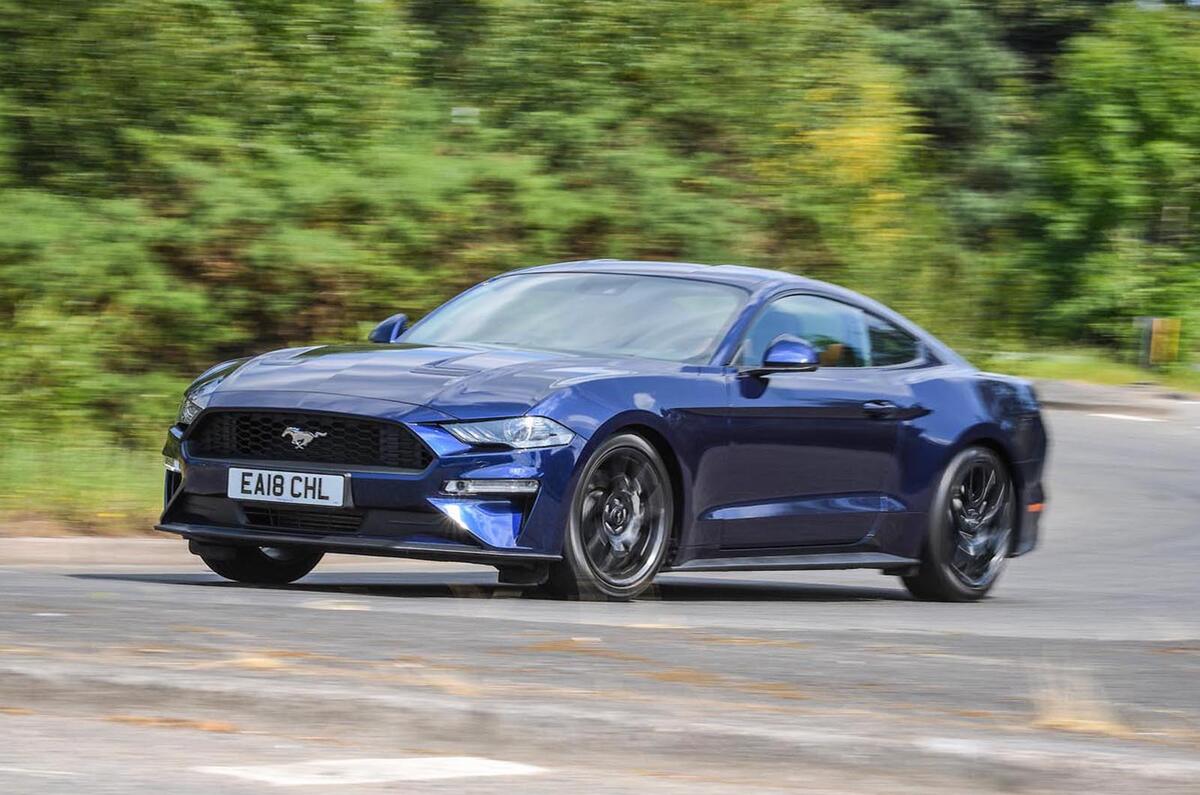What is it?
The inimitable Ford Mustang ‘pony car’ in 2018-model-year, entry-level, four-cylinder turbo form – and driven in the UK for the first time in that particular specification. Having brought us Brits an official factory-built, right-hand-drive Ford Mustang for the first time in 2015, Ford has this year updated the legendary Mustang’s styling and equipment tally, and applied some tweaks to its engines and suspension.
Ford has also introduced the option of a 10-speed automatic gearbox available for both 2.3-litre four-cylinder and 5.0-litre V8 engines – although it’s the 2.3-litre manual we’re testing here.
Compare it with its pre-facelift equivalent and you may wonder how Ford has managed to update both engine and transmission, and yet can have allowed peak power, combined fuel economy and carbon emissions all to slip backwards – the engine’s headline output falling from 313bhp to 286bhp.
The explanation, as you probably won’t be surprised to read, has everything to do with the way that the European emissions testing regime has changed since the introduction of the pre-facelift Mustang; because the Mustang’s real-world performance is almost entirely as it was.



































Join the debate
Add your comment
Excellent touring car
May I add that in terms of car appeal it attracts an amazing amount of positive interest and comment wherever I go in the U.K. and on the continent, ugh more so than any previous ‘prestige’ car I have owned.
Excellent touring car
I have owned a Mustang Ecoboost for 2 years and 13000 miles. I bought it as a long distance touring car because of its large interior and boot size, and forwent the 5.0 V8 for reasons of range on a relatively tiny tank. I have previously owned a number of Jaguar XKs, XKRs and an Aston Martin Vantage, and prefer the Mustang to all of them. It is as fast as the XK 5.0, whilst being roomier and nicer to drive. On both these counts it leaves the Vantage standing. OK, so it doesn’t make as much noise as a V8, but then I don’t have time to roar up and down tunnels with the windows open. OK, it isn’t as plush as the Jag, but then it cost two thirds as much to buy new. When the time comes I will buy another Mustang ecoboost. Smaller, more efficient engines are the future. V8 gas guzzlers are increasingly irrelevant from a performance standpoint, (note very positive reports on the Jag F type 2.0 litre) and posing outside the pub in a 5.0 litre beast is a 5 minute wonder, evidenced by the very short average ownership of such vehicles.
Please Autocar, stop using 'perceived quality.'
Much as i love Autocar, i desperately wish they would stop saying 'perceived quality', they use it in almost all articles to the point of being meaningless. Essentially quality is based on people's opinion, we perceive a heavy sounding door as being high quality, even though a heavy door makes the car slower - so to make a differentiation between perceived and actual quality is almost meaningless. In which case to use the term percevied quality everytime is verbose, and also in grave danger of pretention. It comes across as if you are saying, that i know better, and that it is only perceived quality and not actual quality. I am not saying that there is never an occasion when you might make an observation that something appears to be high quality but actually isn't, but that isn't the usage they are making, they are simply replacing the term quality with the phrase perceived quality.
I apologise if this is slightly ranty, but i have had a San Miguel and most of a bottle of Cava, for no particularly good reason, but seriously there are editors and that they let this go year after year, strikes me as remarkable, i don't understand how they can't see how it appears. Am i the only one? As an aside i also love the way that the autocar reviewers spend ages commenting on the elegance and stylishness of the design, but whenever you see a photo of them in a car they are in the sort of jeans and top you could buy for a tenner on market stall in Bury. It does tend to make you think that they don't really care about design and style, except in so far as it relates to a status item such as a car.
I shall now finish the bottle of Cava, and do something more productive.
Good post. Have more cava,
So, I reckon with a 2.3 four, this is a 1 star, totally pointless, car.
With a 5.0 eight, up to 4.5 stars. Desirable for is good points, and endearing for its crudity.
I have just bought an Isuzu pickup for the farm. I love it, and prefer driving it to any of the courtesy cars I have driven from my Mercedes dealer but an absurd margin.
pushtheprincess wrote:
Not really.
Perceived quality is subjective. It seems, for example, that many people perceive soft plastic dash board mouldings with silver plastic trim to be high quality. Actual quality is more objective, and refers to design and construction of a standard that is fit for purpose and, more or less, isn't likely to go wrong. That's simplifying things, I know, but it does illustrate the very real difference between perceived quality and quality.
Why don't they apply that?
I think i see what you mean (i like the originl post, more Cava and comment please) but Autocar has for years banged on about squishy VW plastics as a sign of "quality" whilst deriding offerings from the East but fail to go into any detail about DSG lawsuits the world over, emissions, below-average reliability ratings. I know they can't bite the hand that feeds them but now they fail to mention interior quality now that VW has rolled it back, just look at the Polo GTI review just released.